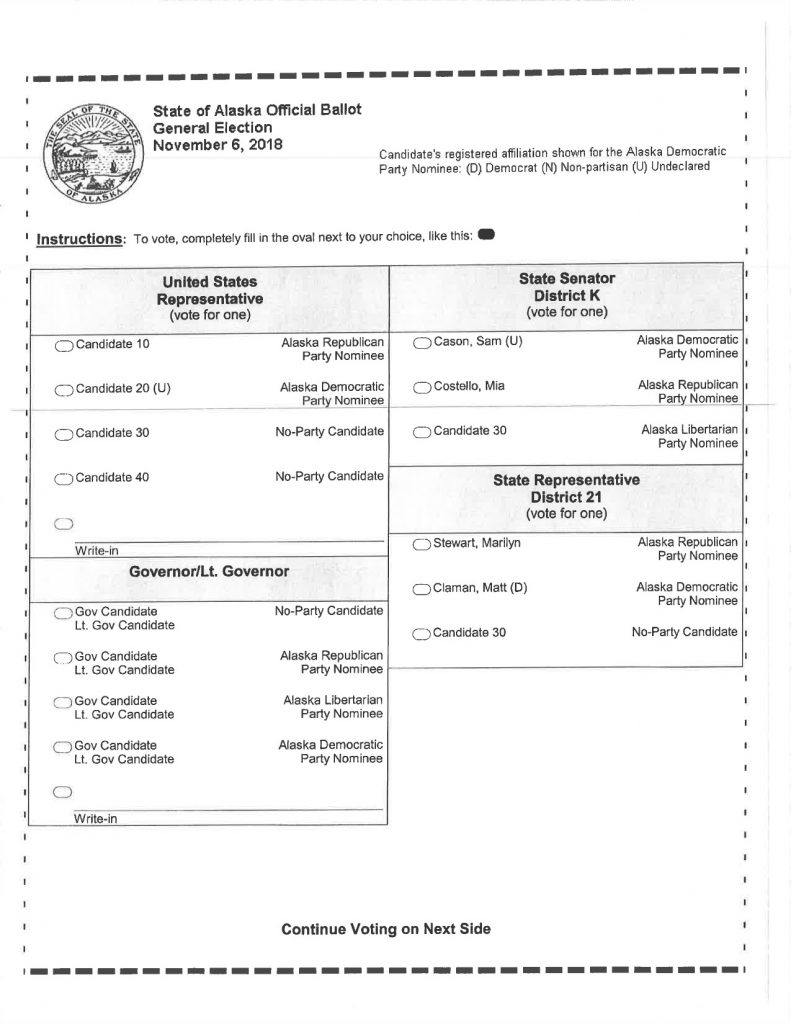DIVISION OF ELECTIONS TRYING TO MAKE IT CLEAR, FAIR
Division of Elections Director Josie Bahnke has a challenge on her hands this summer: Design honest and transparent Primary and General Election ballots that make it clear to voters how each candidate got his or her name on the ballot, as it pertains to the Democrats.
With so many people running as “don’t ask, don’t tell” candidates the Democrat Primary or via petition in the General, it’s not easy to give voters a straight explanation of how the candidates were vetted: Did they go through a primary, or just get 100 or so signatures on a petition to run in the General?
The Division of Elections issued a new draft for the General Election ballot today, possibly moving closer to following a judge’s orders to make the ballot clear. Judge Phillip Pallenburg ordered the division last fall to not follow the Alaska Democratic Party’s plan for their ballot, because it was dishonest with voters.
[Read May’s story: Ballot of the ballot: Sample ballot language released]
Here is what the new General Election ballot looks like, with Democrats having extra letters by their names to indicate what party, if any, they belong to. In this latest version, unlike previous versions, Republicans do not have extra letters by their names:

Normally, it’s simple: Recognized parties in Alaska are Republicans, Democrats, Libertarians, and Alaskan Independence Party.
A recognized political party “is an organized group of voters whose candidate for governor received at least three percent of the total votes cast in the preceding general election or whose number of registered voters is equal to at least three percent of the total votes cast for governor.”
HOW IT BECAME COMPLICATED
But there’s Gov. Walker — the simple carpenter who keeps changing parties and affiliations. In 2014 he was a Republican, and then became an undeclared.
[Read: Assimilation is complete: Walker to run in Democrats’ primary]
By 2018, he said he would remain an undeclared but would run on the Democrats’ Primary ballot.
But a month later, he decided to be a petition candidate on the General Election ballot. He calls it the “Unity” ticket, or labels himself an “Independent.”
The Division of Elections plans to call Walker and his running mate Byron Mallott “No-Party Candidates.”
The Division of Elections current draft is still under review, but must consider these anomalies:
- P.J. Simon, District 1 House, an undeclared candidate going to the General Election ballot via petition. At this time, the Division will list Simon as a “No-Party Candidate.”
- Tim Lamkin, District 4 House, a nonpartisan candidate going to the General Election ballot via petition. At this time, the Division will list Lamkin as a “No-Party Candidate.”
- James Squyres, District 9 House, a Republican-registered candidate going to the General Election ballot via petition, and avoiding the Republican Primary. Squyres will be listed as a “No-Party Candidate.”
- Stephany Jeffers, District 12, an undeclared running in the Democrats primary, who will advance to the General Election and appear with a U next to her name, but as the Democratic Party nominee.
[Read: Supreme Court affirms Democrats’ right to their primary]
Democrats secured the right to allow registered undeclareds, nonpartisans and Democrats to run in their primary in April.
According to Tuckerman Babcock, chairman of the Alaska Republican Party, it is reasonable to accommodate that approach by identifying those Democratic Primary candidates as N, U, or D in the Democratic primary. But when it comes to the General, those candidates are now Democratic nominees — no more and no less.
“In the General Election, the law only requires incontrovertible information — which party are you the nominee of, or did you arrive as a petition (no party) candidate?” Babcock said. “It is not relevant in the General Election to further try to share an individual voter registration because it has a nothing to do with how they got to the General Election ballot. Voter registration can change daily and any registration information on the General Election ballot is potentially incorrect and confusing.”
The Division of Elections currently has been through a couple of iterations of how they were going to handle this confusion. An earlier draft of the ballot had a letter by each candidate’s name, regardless of the party, shown here:

